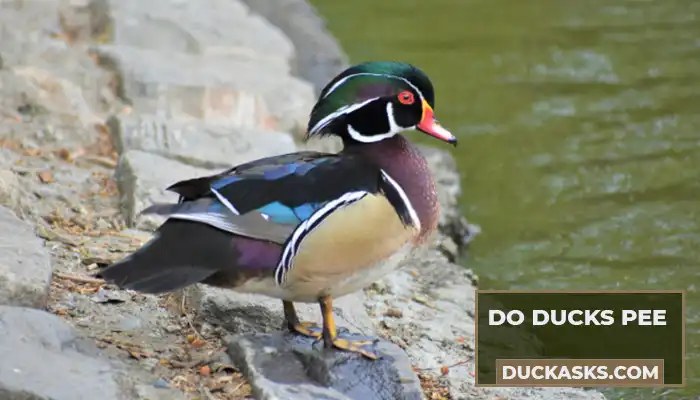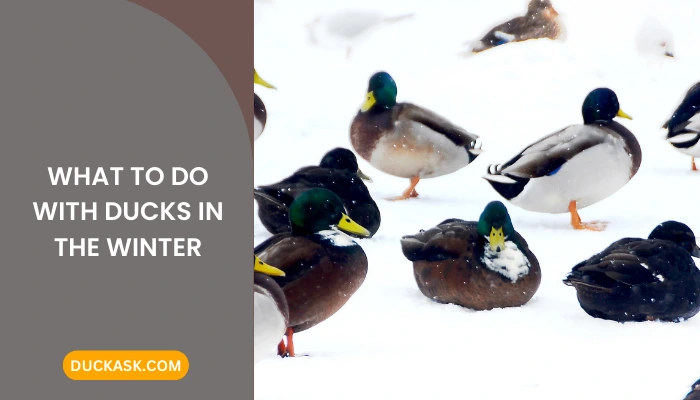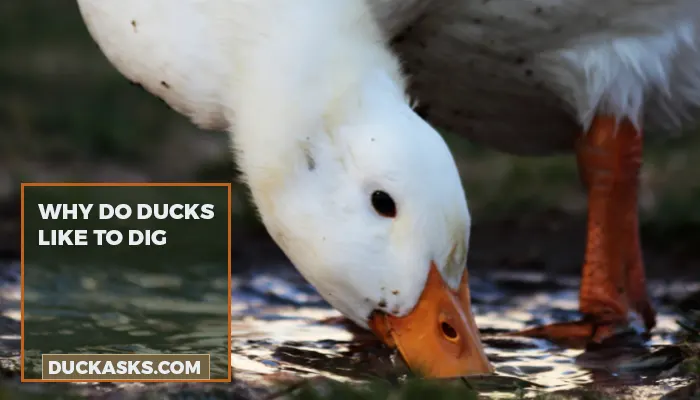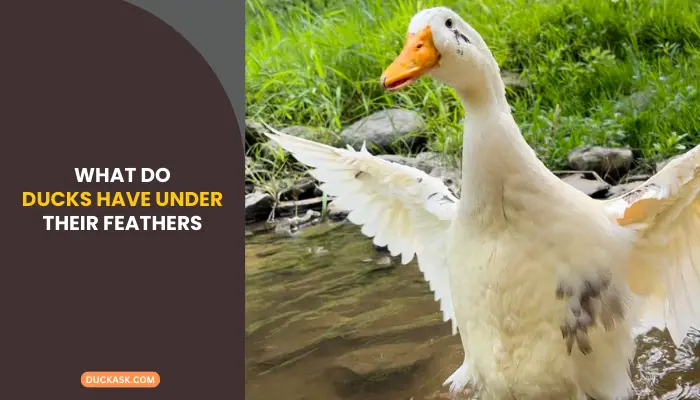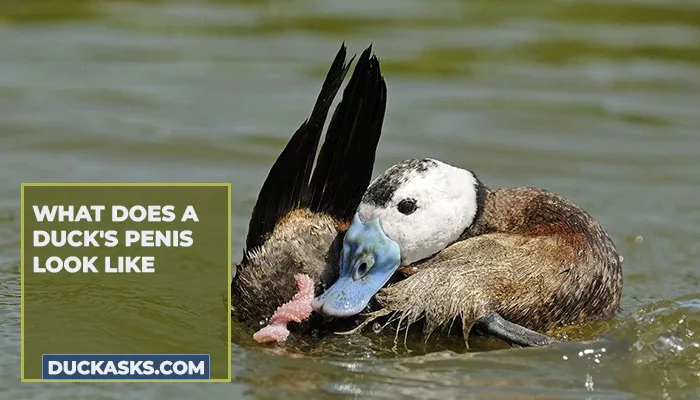What Does A Wood Duck Look Like? Physical Features, Behavior, Habitat, And More!
Do you know that over 130 different species of ducks are found around the world, and all of them have some distinct features?
If you’re from the northern hemisphere, especially North America, you’ve probably heard of or encountered a lot of wood ducks. But probably you couldn’t identify one. So, what does a wood duck look like?
Wood ducks are medium-sized, with a crested and boxy head. They even have thin necks and broad tails. Moreover, there are distinct and colorful features among the male ones and more subtle colored features in the case of the female ones.
These waterfowls also referred to as ‘woodies,’ are probably the most colorful duck species.
But many more interesting facts about their physical or behavioral attributes allow you to identify them quickly. Let’s dive in!
Want to Know More About Duck Blogs:
How Do I Identify a Wood Duck?
Undoubtedly, wood ducks are unique waterfowl feathered birds that are easily identifiable by their physical features, habitat, and behavior. So, if someday you spot a wood duck but don’t know how to confirm it, here are some factors that’ll help you!
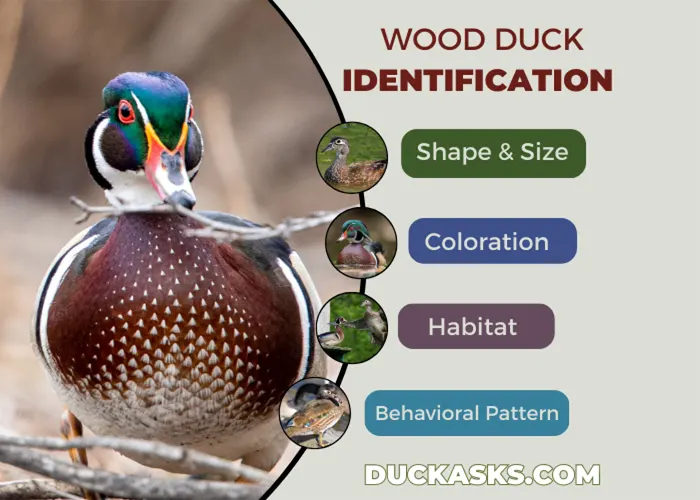
01. Shape and Size
Wood ducks are medium-sized perching birds with long, narrow, and streamlined bodies. They have a distinguishable crest on their head, often called a ‘pompadour‘ or ‘slicked back’ look. The male wood ducks are slightly larger than the females, and both have long, pointed tails.
02. Coloration
In the case of the male wood duck, there is striking and vibrant plumage with iridescent purple and green feathers on the head, bright red eyes, and a white throat. The breast is rich and rusty, and the back is a fusion of green shades, brown, and black.
On the contrary, the female wood duck is less colorful, with a grayish-brown head, a white teardrop around the eye, and a grayish-brown body with a white part on the tummy.
03. Habitat
Wood ducks are primarily found in wetland habitats, such as marshes, swamps, and wooded ponds. Their habitual preferences show they like living in areas with trees and bushy cover near water for foraging and nesting.
04. Behavioral Pattern
These feathered birds are shy and cautious and are seen solitary, in pairs, or in smaller groups swimming on the water. They are known for their ability to perch and nest in trees. Besides, they also have distinct vocalizations, including squeaks, chirps, whistles, etc.
What Duck Looks Similar to a Wood Duck?
Wood ducks, aka ‘woodies’ or Carolina ducks (Aix sponsa), are a type of perching duck. They are widely known for their distinguishable colorful physical features.

However, other perching duck species have many similarities with wood ducks.
Mandarin Duck (Aix galericulata)
At first glance, it is possible to confuse mandarin ducks with wood ducks as both species own bright-colored plumage, with the male mandarin duck featuring a similar combination of blue, iridescent green, and rust tones.
Besides, both species have a crest on their heads despite differences in the shape and size of their crest. However, there are fundamental physical differences between them, such as the more rounded head shape of the mandarin duck compared to the wood duck.
Besides, while wood ducks are native to North America, mandarin ducks are distributed in East Asia.
Green – Winged Teal (Anas carolinensis)
The green-winged teal is another similar duck species to wood ducks. Both the ducks are close in size, small to medium. Besides, they have colorful and distinctive plumage, like wood ducks. On top of that, both species are native to North America.
However, they have behavioral distinctions, such as green-winged teal like to move around in flocks while wood ducks take more solo flights.
What Size Are Wood Ducks? Are They Big in Size?
As you already know, wood ducks are medium-sized duck species, while the male drakes are more significant than the female. Adult male wood ducks typically measure between 19-21 inches in length. They have a pretty good wing span of 26 to 29 inches and, on average, weigh around 1 to 1.6 pounds (450 to 725 gm).
On the other hand, female wood ducks are slightly smaller, measuring around 17 to 19 inches in length on average. They typically have a wingspan of 24 to 26 inches and weigh about 0.9 to 1.2 pounds (400 to 550 gm).
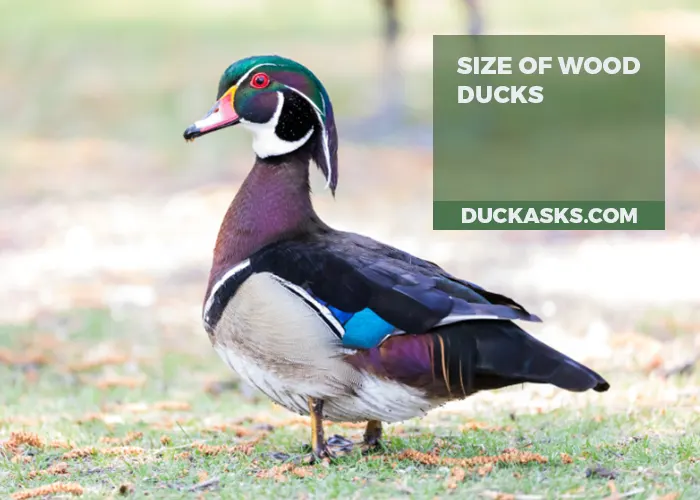
Now, are they big in size? Well, no, you’ll never really spot a big wood duck. They are pretty average-sized ducks weighing between 450 to 725 grams. And the maximum size of the ducks usually ranges between 18 to 20 inches lengthwise. For female wood ducks, the size is even smaller.
When you compare them with other duck types, for instance, mallards, canvasbacks, muscovy ducks, etc., which weigh around 1.4 to 2 kg, wood ducks are relatively small.
What Is the Difference Between a Wood Duck and a Mallard?
No wonder both species of waterfowl, mallards and wood ducks, have distinct features. However, based on the colorful appearance of both species and their belonging to the same family Anatidae, it’s common for people to confuse one with the other. So, if you need to separate them, here’s what to look for.

Size and Shape
Wood ducks are more petite than mallards, with males weighing around 1-1.6 lbs and females weighing no more than 0.8-1.4 lbs.
On the other hand, mallards are larger, with male drakes weighing around 1.8 to 3.5 lbs and females weighing roughly 1.6 to 2.7 lbs.
Type
Wood ducks are part of the Aix genus and are known as perching birds, while mallards are part of the Anas genus and dabbling ducks.
Appearance
Wood ducks have a distinguishable appearance with an iridescent green and purple heat, a white chin, threat, and a unique pattern on their body. Males have more bright and colorful plumage than female hens.
On the other hand, mallards have a mottled brown body, a white neck ring, a green head, and a yellow bill. Males have a glossy green head with a pale-yellow bill, while females have a more orange bill.
Founding Places
The high population of wood ducks is found throughout Northern America, with the highest mass densities in the eastern part of the United States.
Conversely, mallards have a wide distribution worldwide, including Asia, Europe, North America, and some regions of South America.
Diet
Wood ducks primarily rely on plant substances, such as fruits, seeds, and acorns, for their diet. Besides, they also eat a good portion of insects and small invertebrates.
However, mallards are omnivorous, and their diet is pretty vast. They can nibble on plant materials, fruits, and seeds while eating invertebrates, insects, crustaceans, and snails.
Habitual Preference
Preferable habitats by the wood ducks are near wooded wetlands, swamps, and marshes with many trees and vegetation for nesting.
On the other side, Mallards adapt to various habitats. These include wetlands such as ponds, rivers, and lakes while spending time on the grounds or taking flights.
Egg Color and Laying Time
Wood ducks usually lay white-tanned eggs, about 7-15 eggs. In contrast, mallard eggs have white to greenish tones and lay about 8-13 eggs.
Sound
Wood ducks are known for their distinctive high-pitched whistling vocals, almost like a ‘weep-weep-weep.’
On the other hand, mallards have a vocalization that is heavier and a quacking call that is well-known and easy to recognize.
What Does a Male Wood Duck Look Like?
When we point out male wood ducks are mostly known for their striking, colorful plumage and bright-colored feathers. Here are some critical factors of their appearance to pinpoint a male duck.

Head: The male wood duck has a distinctive iridescent green head with a white strip extending from the eye to the back. They also have red eyes, and a unique rest at the back part of their head.
Body: The color of a male wood duck’s body is mostly chestnut brown with black and white markings on its wings. Their breast is a bright metallic purple, and their belly is white.
Legs: They have relatively shorter legs with a yellow-orange color.
Bill: With a black bill that is short yet wide, the male wood ducks are pretty recognizable.
What Does a Female Wood Duck Look Like?
Although not as distinctive as the male wood ducks, the female hens still look striking. Here’s how to identify one.

Head: They have slightly less rounded heads of gray color, with dark brown eyes. Surrounding the eyes is a white teardrop-shaped ring. Besides, the feature that easily allows one to identify them is a prominent crest of feathers at the back of their head and a white patch around the throat and chin.
Body: The female’s body is gray-brown, which allows them to blend in with nature, while her breast is dotted with white. They are smaller than male wood ducks, about 17-19 inches in length.
Legs: Female wood ducks have sorter, stout legs with a grayish-brown hue.
Bill: Her bill is short and dark, just the perfect size for catching insects and small invertebrates in the water.
Feathers: Female wood ducks have a distinctive pattern of feathers on their wings, with a white stripe running along the edge of the wing. The wings of the females are marked with a dark blue-purple hue. In the case of the tail feathers, they are pointed and longer than that of the males.
Do Male Wood Ducks Change Color?
No wonder male wood ducks are one of the most vibrant and colorful birds in Northern America. However, an interesting fact about the male drakes is that the intensity of their colors changes over time.

Younger male wood ducks have less vibrant plumage and may even lack the distinctive marking as seen in adults. However, they get a more pronounced color and distinct patterns as they mature and reach breeding age.
They use vibrant markings during the breeding season, winning from autumn to early summer to attract females. At the end of the breeding season, usually in late summer, they lose their colorful plumage and grow grayish feathers.
This camouflage during the non-breeding season helps them to blend in with their surroundings and avoid predators.
Parting Words
There’s no way you will miss a wood duck if you ever spot one since a wood duck looks pretty much like a feathered bundle of colors. Although the male wood ducks have more prominent and colorful features, you can’t miss the stunning purple-hued wings of the female wood ducks.
So, after going through this blog, you should now have a clear understanding of what wood ducks look like. If this article was helpful, do share it, and for more interesting facts, connect with us through Facebook, Twitter, and Pinterest.
Article References:
- https://www.nwf.org/Educational-Resources/Wildlife-Guide/Birds/Wood-Duck
- https://study.com/academy/lesson/wood-duck-facts-lesson-for-kids.html
- https://www.allaboutbirds.org/guide/Wood_Duck/species-compare/
- https://a-z-animals.com/blog/wood-duck-vs-mallard-what-are-the-differences/
Image Credit:
Canva.com/photos

